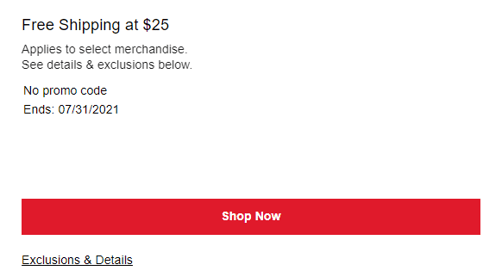- July 15, 2021
- Clayton Prickett
- Communications/Media
 In 2020, over two billion people purchased goods and services online. This growth in online sales – which spiked during the pandemic – is expected to continue. As more customers rely on the internet to purchase goods and services, businesses will need to maintain an online presence to remain competitive. This post addresses some of the statutory and regulatory requirements for running an online advertising campaign and promoting a business online.
In 2020, over two billion people purchased goods and services online. This growth in online sales – which spiked during the pandemic – is expected to continue. As more customers rely on the internet to purchase goods and services, businesses will need to maintain an online presence to remain competitive. This post addresses some of the statutory and regulatory requirements for running an online advertising campaign and promoting a business online.
The Federal Trade Commission ("FTC") prohibits unfair or deceptive advertising practices. An advertisement is unfair if it is likely to cause an injury to the consumer that he or she could not avoid (e.g., hidden fees on an item listed as "free" or advertising a warranty where none exists). An advertisement is deceptive if it contains a statement (or leaves out information) that is likely to mislead a reasonable consumer into purchasing the product or service. The FTC's regulations apply to online advertising and social media marketing.
For advertising and promotional campaigns to comply with FTC regulations, clear and conspicuous disclosures are needed. In general, the FTC recommends incorporating the relevant limitations and qualifying information into the underlying advertisement, rather than having a separate disclosure qualifying the claim.
Terms and Conditions. Promotions must include sufficient information to avoid deceptive advertising. Generally, the terms and conditions should include (1) a specific expiration date (not phrases such as "this week only"); (2) the form of the discount, such as dollars off, percent off, buy-one-get-one-free; (3) the discount does not apply to taxes or shipping and handling fees; (4) the discount cannot be combined with another coupon or offer; (5) the coupon or promotion code has no cash value; and (6) if any products purchased under the promotion are returned, then the refund will equal the amount the customer paid, subject to applicable refund policies.
Businesses can also incorporate terms and conditions that are specific to online promotions:
First, the promotion can apply only to items purchased in a single order shipped at the same speed to the same address. This can limit shipping costs on products sold at a discount.
Second, the terms and conditions can limit the promotion to products purchased through the business' website only and do not apply to products purchased through third-party vendors. This can prevent a business from having to continually update its prices on sites like Amazon to reflect current promotional pricing.
Third, if customers can apply promotion codes to reduced-priced items, then state that any percent-off promotion applies to the reduced price of an item (as opposed to a percent-off the original price). If customers cannot apply promotion codes to reduced-priced items, then state that in the terms and conditions.

Format and Location. The FTC recommends placing disclosures on the same page as the promotion and linking, if necessary, the more complicated information according to the guidelines discussed below. Information affecting the actual cost of an offer should be disclosed near the advertised price on the same electronic page. This includes, for example, "offer valid through [date]," "while supplies last," or other information that conveys to the consumer that the price is part of a promotion.

The FTC says that disclosures not directly affecting the price (or certain health and safety disclosures) can be placed in hyperlinked terms and conditions or in plain text in the promotion itself. If a business links its promotional terms and conditions, then the link should be placed near the promotion. The FTC cautions against burying hyperlinked terms and conditions at the bottom of the webpage next to general links like "privacy policy," or "copyright information," as customers rarely look at this information. The hyperlink should be labeled in a way that conveys to the reader the importance of the link and relate to the information to which it links (e.g., "promotional terms and conditions apply" placed very close to "10-percent off sale"). General descriptors such as "details here," "disclaimer," or "more information" should not be used.
The FTC advises that Terms and conditions should be compatible across different electronic devices. The promotion's terms and conditions must be visible and accessible regardless of the device on which they are accessed, including desktops, laptops, tablets, and smartphones. The FTC says that plain text is the best way to ensure customers can access the relevant information from any device. Terms and conditions should not be placed in Adobe Flash Player because Adobe is not compatible with smart phones. Similarly, pop-up windows with important information should not be used, as many users have ad-blockers or will close out of the pop-up without reading it.

Advertising Reduced Prices. A business can advertise price reductions on specific items, with or without the original price listed, so long as the original price was not artificially inflated. 16 C.F.R. § 233.1. Best practices, however, recommend listing the original price.

A reduced-price promotion that compares the original price to the discounted price must be a legitimate price reduction. The original price must have been offered to the public on a regular basis for a reasonably substantial period. The FTC generally interprets a reasonably substantial period as 30 days. A reduction cannot be advertised where the product was never offered for sale at the original price.
"Up To" Discounts. Advertising "up to 40-percent off" or "save up to $300" during a promotion has the potential to be misleading, as well. The FTC expects advertisers who make these offers to demonstrate that all or almost all customers are likely to achieve the maximum "up to" results. Otherwise, the business must disclose the specific circumstances clearly and prominently under which customers are likely to achieve the maximum "up to" results.
When using an "up to" promotion, disclose the price range (i.e., the highest and lowest prices or the greatest and least reduction in prices) and convey to the customer how he or she can obtain the maximum discount promised (e.g., "maximum discount earned by purchasing products A, B, and C in the same order").
Competitive Comparisons. A business may truthfully compare its products to competitive brands on objectively measurable attributes such as price (or calories). It may identify competing products by brand name, illustration, or other distinctive information; however, the FTC stresses that such advertising must, again, be truthful and not deceptive. Before running a competitive comparison, it is best to carefully document evidence to support the comparison.
Email Advertising Campaigns. An email advertising campaign must comply with the CAN-SPAM Act ("CAN-SPAM"). CAN-SPAM is a federal law governing commercial email. Email is commercial if it has the primary purpose of advertising or promoting a product or service. CAN-SPAM requires truthful, non-misleading email and a simple opt-out procedure.
CAN-SPAM prevents a business from sending untruthful or misleading commercial email. Untruthful or misleading practices include using subject lines that do not reflect the email's content or disguising the person or business that sent the message. Commercial email must also include the physical mailing address of the business sending the message. In addition, if it is not clear from the email's content that the message was sent for commercial purposes, then the message must be identified as an advertisement. For example, a 20-percent-off coupon would likely not need to be identified as an advertisement; but a personal narrative about why the recipient should buy X-Brand widgets would likely need a disclaimer.
CAN-SPAM also requires that commercial email contain a clear and conspicuous explanation as to how the recipient can opt out of receiving future messages. A business must allow the recipient to opt out by replying to the message or visiting a link to a single, separate website where the recipient can opt out. The business cannot redirect the customer to multiple websites, charge an opt-out fee, or require the customer to provide any personal information except his or her email address. Opt-out requests must be honored within 10 business days. Once the customer completes the opt-out procedure, the business cannot sell or transfer the customer's email address.
Businesses can send commercial email to anyone, but best practices recommend sending commercial email only to recipients that opt in to receiving promotional content. Each separate email that violates CAN-SPAM is subject to penalties up to $43,792, so non-compliance can be costly.
Don’t forget about State Law Requirements. Every state has laws against false advertising. State law prohibits much of the same conduct as the FTC regulations, but states provide additional remedies for the injured party. Indeed, most states provide competitors and consumers a private right of action for false and misleading advertising. States also allow statutory penalties (ranging from $50 to over $2,500) for each illegal advertisement, which can grow exponentially based on how easy it is to distribute electronic advertisements.
Conclusion. Maintaining an online presence is crucial to a business' long-term success. Before engaging in the online marketplace, however, a business must ensure that its online marketing efforts comply with all applicable laws and regulations.
This post is for informational purposes only; the information contained in this post does not constitute, and should not be relied on, as legal advice.
